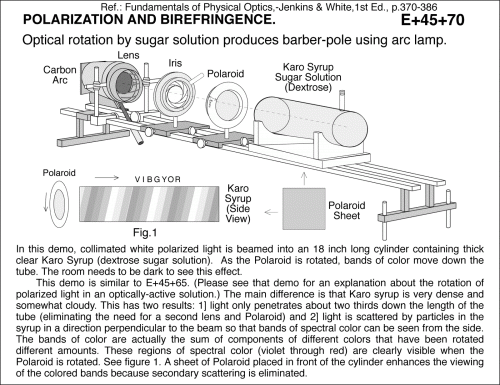Optical rotation by sugar solution produces barber pole, using arc lamp.
Primary tabs
In this demo, collimated white polarized light is beamed into an 18 inch long cylinder containing thick clear Karo Syrup (dextrose sugar solution). As the Polaroid is rotated, bands of color move down the tube. The room needs to be dark to see this effect. This demo is similar to X. (Please see that demo for an explanation about the rotation of polarized light in an optically-active solution.) The main difference is that Karo syrup is very dense and somewhat cloudy. This has two results: 1] light only penetrates about two thirds down the length of the tube (eliminating the need for a second lens and Polaroid) and 2] light is scattered by particles in the syrup in a direction perpendicular to the beam so that bands of spectral color can be seen from the side. The bands of color are actually the sum of components of different colors that have been rotated different amounts. These regions of spectral color (violet through red) are clearly visible when the Polaroid is rotated. See figure 1. A sheet of Polaroid placed in front of the cylinder enhances the viewing of the colored bands because secondary scattering is eliminated. Optical rotation by sugar solution produces barber-pole using arc lamp. Ref.: Fundamentals of Physical Optics,-Jenkins & White,1st Ed., p.370-386
UCB Index:
E+45+70
PIRA Index:
6H30.30
UCB Taxonomy:
PIRA Taxonomy:
appletURL:
Popularity:
- Log in to post comments

